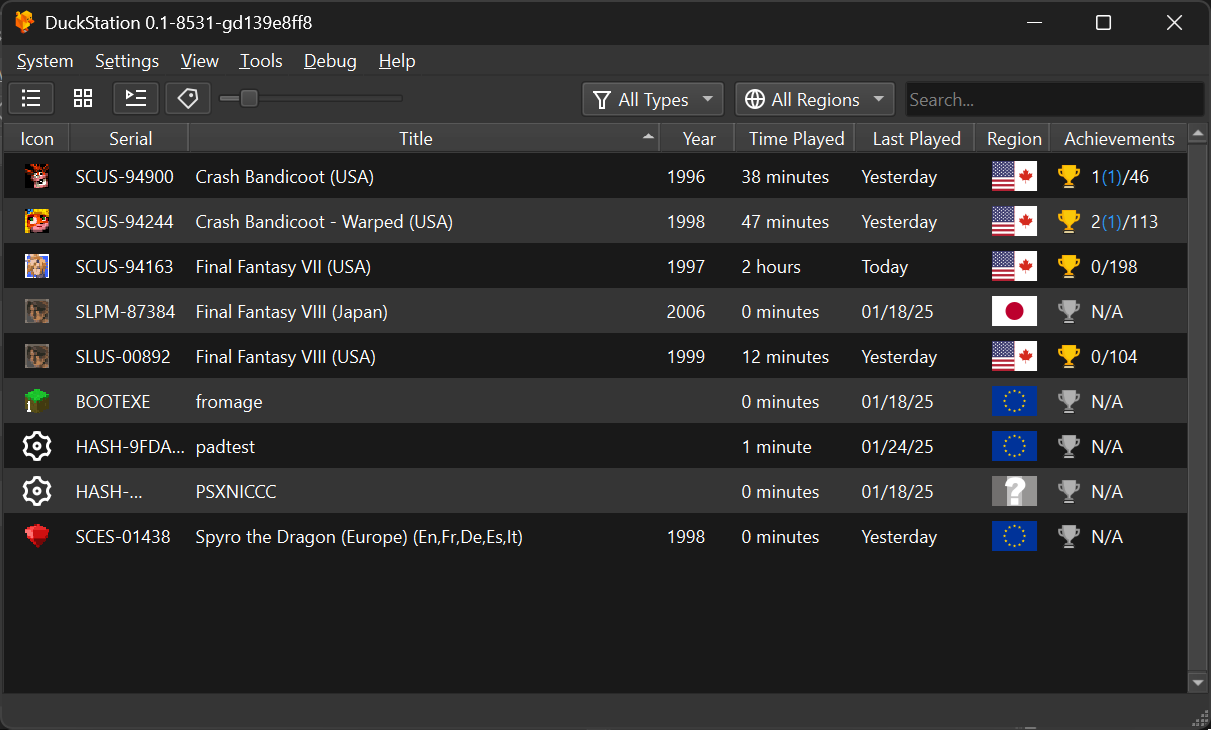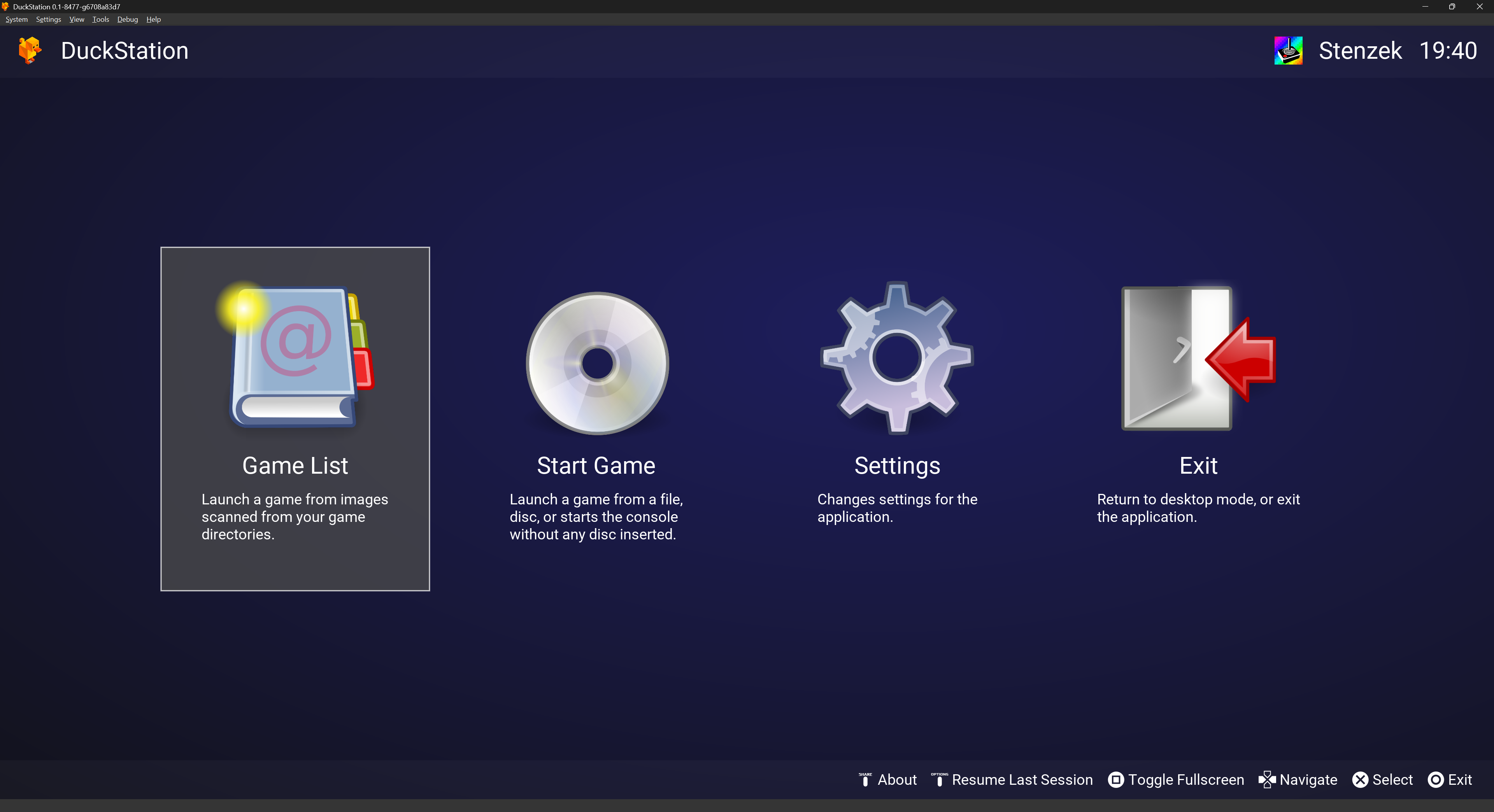Features | Downloading and Running | Building | Disclaimers
Latest Builds for Windows 10/11, Linux (AppImage/Flatpak), and macOS: https://github.com/stenzek/duckstation/releases/tag/latest
Game Compatibility List: https://docs.google.com/spreadsheets/d/1H66MxViRjjE5f8hOl5RQmF5woS1murio2dsLn14kEqo/edit
Wiki: https://www.duckstation.org/wiki/
DuckStation is an simulator/emulator of the Sony PlayStation(TM) console, focusing on playability, speed, and long-term maintainability. The goal is to be as accurate as possible while maintaining performance suitable for low-end devices. "Hack" options are discouraged, the default configuration should support all playable games with only some of the enhancements having compatibility issues.
A "BIOS" ROM image is required to to start the emulator and to play games. You can use an image from any hardware version or region, although mismatching game regions and BIOS regions may have compatibility issues. A ROM image is not provided with the emulator for legal reasons, you should dump this from your own console using Caetla or other means.
DuckStation features a fully-featured frontend built using Qt, as well as a fullscreen/TV UI based on Dear ImGui.
Other features include:
- CPU Recompiler/JIT (x86-64, armv7/AArch32, AArch64, RISC-V/RV64).
- Hardware (D3D11, D3D12, OpenGL, Vulkan, Metal) and software rendering.
- Upscaling, texture filtering, and true colour (24-bit) in hardware renderers.
- PGXP for geometry precision, texture correction, and depth buffer emulation.
- Adaptive downsampling filter.
- Post processing shader chains (GLSL and experimental Reshade FX).
- "Fast boot" for skipping BIOS splash/intro.
- Save state support.
- Windows, Linux, macOS support.
- Supports bin/cue images, raw bin/img files, MAME CHD, single-track ECM, MDS/MDF, and unencrypted PBP formats.
- Direct booting of homebrew executables.
- Direct loading of Portable Sound Format (psf) files.
- Digital and analog controllers for input (rumble is forwarded to host).
- Namco GunCon lightgun support (simulated with mouse).
- NeGcon support.
- Qt and "Big Picture" UI.
- Automatic updates with preview and latest channels.
- Automatic content scanning - game titles/hashes are provided by redump.org.
- Optional automatic switching of memory cards for each game.
- Supports loading cheats from existing lists.
- Memory card editor and save importer.
- Emulated CPU overclocking.
- Integrated and remote debugging.
- Multitap controllers (up to 8 devices).
- RetroAchievements.
- Automatic loading/applying of PPF patches.
- A CPU faster than a potato. But it needs to be x86_64, AArch32/armv7, AArch64/ARMv8, or RISC-V/RV64 otherwise you won't get a recompiler and it'll be slow.
- For the hardware renderers, a GPU capable of OpenGL 3.1/OpenGL ES 3.1/Direct3D 11 Feature Level 10.0 (or Vulkan 1.1) and above. So, basically anything made in the last 10 years or so.
- SDL, XInput or DInput compatible game controller (e.g. XB360/XBOne/XBSeries). DualShock 3 users on Windows will need to install the official DualShock 3 drivers included as part of PlayStation Now.
Binaries of DuckStation for Windows x64/ARM64, Linux x86_64 (in AppImage/Flatpak formats), and macOS Universal Binaries are available via GitHub Releases and are automatically built with every commit/push. Binaries or packages distributed through other sources may be out of date and are not supported by the developer, please speak to them for support, not us.
DuckStation requires Windows 10/11, specifically version 1809 or newer. If you are still using Windows 7/8/8.1, DuckStation will not run on your operating system. Running these operating systems in 2023 should be considered a security risk, and I would recommend updating to something which receives vendor support. If you must use an older operating system, v0.1-5624 is the last version which will run. But do not expect to recieve any assistance, these builds are no longer supported.
To download:
- Go to https://github.com/stenzek/duckstation/releases/tag/latest, and download the Windows x64 build. This is a zip archive containing the prebuilt binary.
- Alternatively, direct download link: https://github.com/stenzek/duckstation/releases/download/latest/duckstation-windows-x64-release.zip
- Extract the archive to a subdirectory. The archive has no root subdirectory, so extracting to the current directory will drop a bunch of files in your download directory if you do not extract to a subdirectory.
Once downloaded and extracted, you can launch the emulator with duckstation-qt-x64-ReleaseLTCG.exe. Follow the Setup Wizard to get started.
If you get an error about vcruntime140_1.dll being missing, you will need to update your Visual C++ runtime. You can do that from this page: https://support.microsoft.com/en-au/help/2977003/the-latest-supported-visual-c-downloads. Specifically, you want the x64 runtime, which can be downloaded from https://aka.ms/vs/17/release/vc_redist.x64.exe.
The only supported version of DuckStation for Linux are the AppImage and Flatpak in the releases page. If you installed DuckStation from another source or distribution (e.g. EmuDeck), you should contact the packager for support, we have no control over it.
The AppImages require a distribution equivalent to Ubuntu 22.04 or newer to run.
- Go to https://github.com/stenzek/duckstation/releases/tag/latest, and download
duckstation-x64.AppImage. - Run
chmod a+xon the downloaded AppImage -- following this step, the AppImage can be run like a typical executable.
- Go to https://github.com/stenzek/duckstation/releases/tag/latest, and download
duckstation-x64.flatpak. - Run
flatpak install ./duckstation-x64.flatpak.
or, if you have FlatHub set up:
- Run
flatpak install org.duckstation.DuckStation.
Use flatpak run org.duckstation.DuckStation to start, or select DuckStation in the launcher of your desktop environment. Follow the Setup Wizard to get started.
Universal MacOS builds are provided for both x64 and ARM64 (Apple Silicon).
MacOS Big Sir (11.0) is required, as this is also the minimum requirement for Qt.
To download:
- Go to https://github.com/stenzek/duckstation/releases/tag/latest, and download
duckstation-mac-release.zip. - Extract the zip by double-clicking it.
- Open DuckStation.app, optionally moving it to your desired location first.
- Depending on GateKeeper configuration, you may need to right click -> Open the first time you run it, as code signing certificates are out of the question for a project which brings in zero revenue.
You will need a device with armv7 (32-bit ARM), AArch64 (64-bit ARM), or x86_64 (64-bit x86). 64-bit is preferred, the requirements are higher for 32-bit, you'll probably want at least a 1.5GHz CPU.
Google Play is the preferred distribution mechanism and will result in smaller download sizes: https://play.google.com/store/apps/details?id=com.github.stenzek.duckstation
No support is provided for the Android app, it is free and your expectations should be in line with that. Please do not email me about issues about it, or ask for help, you will be ignored.
If you must use an APK, download links are listed in https://www.duckstation.org/android/
To use:
- Install and run the app for the first time.
- Follow the setup wizard.
If you have an external controller, you will need to map the buttons and sticks in settings.
A number of PAL region games use LibCrypt protection, requiring additional CD subchannel information to run properly. libcrypt not functioning usually manifests as hanging or crashing, but can sometimes affect gameplay too, depending on how the game implemented it.
For these games, make sure that the CD image and its corresponding SBI (.sbi) file have the same name and are placed in the same directory. DuckStation will automatically load the SBI file when it is found next to the CD image.
For example, if your disc image was named Spyro3.cue, you would place the SBI file in the same directory, and name it Spyro3.sbi.
CHD images with built-in subchannel information are also supported.
Requirements:
- Visual Studio 2022
- Clone the respository:
git clone https://github.com/stenzek/duckstation.git. - Download the dependencies pack from https://github.com/stenzek/duckstation-ext-qt-minimal/releases/download/latest/deps-x64.7z, and extract it to
dep\msvc. - Open the Visual Studio solution
duckstation.slnin the root, or "Open Folder" for cmake build. - Build solution.
- Binaries are located in
bin/x64. - Run
duckstation-qt-x64-Release.exeor whichever config you used.
Requirements (Debian/Ubuntu package names):
- CMake (
cmake) - SDL2 (at least version 2.28.5) (
libsdl2-devlibxrandr-dev) - pkgconfig (
pkg-config) - Qt 6 (at least version 6.5.3) (
qt6-base-devqt6-base-private-devqt6-base-dev-toolsqt6-tools-devlibqt6svg6) - git (
git) (Note: needed to clone the repository and at build time) - When Wayland is enabled (default): (
libwayland-devlibwayland-egl-backend-devextra-cmake-modulesqt6-wayland) - libcurl (
libcurl4-openssl-dev) - Optional for faster building: Ninja (
ninja-build)
- Clone the repository:
git clone https://github.com/stenzek/duckstation.git -b dev. - Create a build directory, either in-tree or elsewhere.
- Run CMake to configure the build system. Assuming a build subdirectory of
build-release, runcmake -Bbuild-release -DCMAKE_BUILD_TYPE=Release. If you have installed Ninja, add-GNinjaat the end of the CMake command line for faster builds. - Compile the source code. For the example above, run
cmake --build build-release --parallel. - Run the binary, located in the build directory under
bin/duckstation-qt.
Requirements:
- CMake
- SDL2 (at least version 2.28.5)
- Qt 6 (at least version 6.5.3)
Optional (recommended for faster builds):
- Ninja
- Clone the repository:
git clone https://github.com/stenzek/duckstation.git. - Run CMake to configure the build system:
cmake -Bbuild-release -DCMAKE_BUILD_TYPE=Release. You may need to specify-DQt6_DIRdepending on your system. If you have installed Ninja, add-GNinjaat the end of the CMake command line for faster builds. - Compile the source code:
cmake --build build-release --parallel. - Run the binary, located in the build directory under
bin/DuckStation.app.
The "User Directory" is where you should place your BIOS images, where settings are saved to, and memory cards/save states are saved by default. An optional SDL game controller database file can be also placed here.
This is located in the following places depending on the platform you're using:
- Windows: My Documents\DuckStation
- Linux:
$XDG_DATA_HOME/duckstation, or~/.local/share/duckstation. - macOS:
~/Library/Application Support/DuckStation.
So, if you were using Linux, you would place your BIOS images in ~/.local/share/duckstation/bios. This directory will be created upon running DuckStation
for the first time.
If you wish to use a "portable" build, where the user directory is the same as where the executable is located, create an empty file named portable.txt
in the same directory as the DuckStation executable.
Your keyboard or game controller can be used to simulate a variety of PlayStation controllers. Controller input is supported through DInput, XInput, and SDL backends and can be changed through Settings -> General Settings.
To bind your input device, go to Settings -> Controllers. Each of the buttons/axes for the simulated controller will be listed, alongside the corresponding key/button on your device that it is currently bound to. To rebind, click the box next to the button/axis name, and press the key or button on your input device that you wish to bind to. When binding rumble, simply press any button on the controller you wish to send rumble to.
DuckStation releases ship with a database of game controller mappings for the SDL controller backend, courtesy of https://github.com/gabomdq/SDL_GameControllerDB. The included gamecontrollerdb.txt file can be found in the database subdirectory of the DuckStation program directory.
If you are experiencing issues binding your controller with the SDL controller backend, you may need to add a custom mapping to the database file. Make a copy of gamecontrollerdb.txt and place it in your user directory (or directly in the program directory, if running in portable mode) and then follow the instructions in the SDL_GameControllerDB repository for creating a new mapping. Add this mapping to the new copy of gamecontrollerdb.txt and your controller should then be recognized properly.
Controller 1:
- Left Stick: W/A/S/D
- Right Stick: T/F/G/H
- D-Pad: Up/Left/Down/Right
- Triangle/Square/Circle/Cross: I/J/L/K
- L1/R1: Q/E
- L2/R2: 1/3
- L3/R3: 2/4
- Start: Enter
- Select: Backspace
Hotkeys:
- Escape: Open Pause Menu
- F11: Toggle Fullscreen
- Tab: Temporarily Disable Speed Limiter
- Space: Pause/Resume Emulation
Icon by icons8: https://icons8.com/icon/74847/platforms.undefined.short-title
"PlayStation" and "PSX" are registered trademarks of Sony Interactive Entertainment Europe Limited. This project is not affiliated in any way with Sony Interactive Entertainment.

